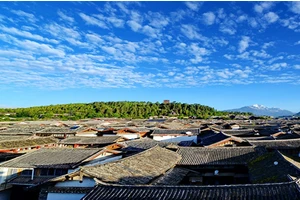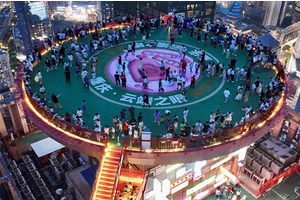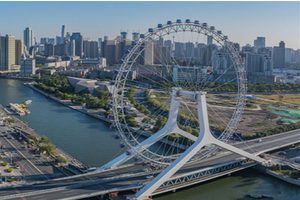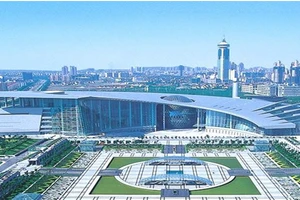Baotou tourist grassland
I know this! Last year, when I was planning to travel to Baotou with my friends, I collected some information about the must-see attractions in Baotou. Now I will share the information of the top ten must-see attractions in Baotou with the needy friends ~
1. Xilamuren Grassland
brief introduction
Grassland is located in AnLianhe Banner, Darhanmao County, Baotou City, which is a typical desert grassland.
With more than 700 square kilometers of natural grassland, the scenery is magnificent, visitors can board Aobao, and the blue sky and green grass will have a panoramic view, which is beautiful.
In addition to sightseeing here, you can also ride horses, enjoy folk songs and dances, taste grassland-style catering and experience the heroic cultural customs of Mongolians.
telephone
15335564028
Time reference
1 day
traffic
[Starting from Baotou]
Take a long-distance bus to Bailingmiao Town at Baotou coach station, and then take a long-distance bus from Bailingmiao or take a taxi or charter bus to Xilamuren grassland. You can also take a bus from Hohhot to the Xilamuren grassland. It is best to call before coming.
entrance ticket
be free of charge
tips:
Please consult the scenic spot for details.
opening hours
whole day
Location of scenic spots
Wen Du Ri Zhu Si Leng, Xilamuren Town, Darhanmaoming Lianhe Banner, Baotou City, Inner Mongolia Autonomous Region
2. Saihantala Ecological Park
brief introduction
Saihantala Ecological Park, located in the southeast of Qingshan District, Baotou City, is a modern grassland tourist attraction with strong ethnic customs. Saihantala means "beautiful grassland" in Mongolian, with a total area of 537 hectares and a grassland area of 380 hectares, which is an out-and-out "grassland in the city". One second, you are still shuttling through the urban jungle, and the next, you have stepped into the beautiful grassland full of green grass and wild flowers, with white yurts scattered in it. In Saihantala Ecological Park, you can not only stroll among wild flowers and green grass, but also ride your horse under the blue sky and white clouds. There are a variety of entertainment items here, such as horse riding, archery, camel riding, etc., with well-equipped racecourse and archery range, bonfire parties, and special folk song and dance performances, which can let you experience the Inner Mongolia customs of rushing and unrestrained, singing and dancing at one time. When you come here in winter, you can also enjoy skiing on the grassland.
telephone
0472-5110616
Time reference
More than 3 hours
traffic
Take Bus No.5, Bus No.10, Bus No.35, Bus No.10 and Bus No.5 in Baotou, and get off at Saihantala Park Station.
entrance ticket
Tickets are free; All kinds of entertainment in the park need to be charged separately.
opening hours
All day (all day)
(Monday-Sunday, January 1st-December 31st)
Location of scenic spots
South of the intersection of Minzhu Road and Jianshe Road, Qingshan District, Baotou City, Inner Mongolia Autonomous Region
3. North Weapon City
brief introduction
Located in Qingshan Road, Qingshan District, Baotou City, Northern Weapon City is a special tourist attraction invested and built by China Weapon Inner Mongolia North Heavy Industry Group Co., Ltd., which integrates national defense, weapon exhibition, military culture dissemination and leisure and entertainment, and is also a key patriotic education base in Baotou City.
Entering the main entrance of the Weapons City, you can see the main square area of the Weapons City. There are nine granite cultural columns with a height of 9 meters, representing the nine districts and counties under the jurisdiction of Baotou City. The columns are carved with the customs of Baotou and the myths and legends of Inner Mongolia. There are weapons display areas on both sides of the square area, displaying various representative weapons, such as Soviet-made artillery during the Great Patriotic War of the Soviet Union; The first 100-gun anti-aircraft gun developed by the Republic, the "First Gun of the Republic" reviewed by President Mao Zedong on the 10th anniversary of the founding of the People's Republic of China, can be feasted by military enthusiasts. The underground of Weapon City displays conventional light weapons, providing physical objects, models and pictures of light weapons, as well as supporting facilities such as pistols, machine guns and live ammunition laboratories. The national defense education exhibition hall, through the high-tech sound and photoelectric system, shows the wonderful scenes of famous battles at home and abroad to tourists and provides them with national defense education. Peace Square, located in the south of Weapon City, is a wide venue, and now it is a place for citizens to relax and keep fit. Northern Weapon City gives people a glimpse of conventional weapons, and now it has become a famous characteristic landscape in Baotou and even Inner Mongolia.
telephone
0472-3303120
Time reference
More than 3 hours
traffic
Take bus No.25 in Baotou City, get off at Beizhong Training Center Station and walk to Weapon City. Take bus No.21 and get off at North Hotel Station, then walk to Weapon City. Take bus No.26 and get off at Qingshan Traffic Police Brigade Station, and walk along Qingshan Road and Fuqiang Road for 1 km to reach Weapon City.
entrance ticket
Adult ticket: 15 RMB (from January 1 to December 31, Monday to Sunday)
Students: Full-time students, with their valid Student ID card registered in the school (excluding doctors, masters, adult students and international students), with half price.
Free ticket: children: children under 1.2 meters (excluding), free of charge.
Old people: 65 years old (inclusive) -69 years old (inclusive) with my valid ID card and senior citizen discount card, half price; Older people over 70 years old (including 65 years old), with their valid "resident ID card" and old-age card, are free.
Disabled: Free of charge with valid disability certificate.
Reporter: Holding the Press Card issued by the State Press and Publication Administration is free of charge.
Military personnel: active and retired military personnel hold their valid certificates (officer's card, soldier's card, civilian cadre's card) free of charge.
Tour guide/travel agency manager: holders of national tour guide certificate and travel agency manager qualification certificate are free of charge.
opening hours
08:00-19:00 (all day); Closing time: 18: 30 (Monday-Sunday, June 1st-August 31st)
08:00-18:00 (all day); Closing time: 18: 00 (December 1st-Monday-Sunday of February 28th of the following year).
Location of scenic spots
Binggong Road, Qingshan District, Baotou City, Inner Mongolia Autonomous Region
4. Nanhai Wetland Scenic Area
brief introduction
The South China Sea Yellow River Wetland Scenic Area is located in the south of donghe district, which is the second bend of the Jiuqu Yellow River in Baotou. As the Yellow River is diverted to the south, lakes and tidal flats are formed here. The 1,664-hectare Nanhai Wetland Scenic Area is an ideal place for ecological sightseeing and leisure, which integrates the city, the Yellow River and the wetland landscape and is home to more than 200 kinds of wild animals and plants. There are ten famous scenic spots in the scenic spot, which are warm and quiet time and space docks; The "South China Sea Tea Asking" by literati and poets in past dynasties; Legend has it that "Wild Goose Beach" and "Zhaojun Crossing" are related to Zhaojun's departure from the fortress; "Shuanglong Tucui", which embodies the deep relationship between the South China Sea and the Jiuqu Yellow River; Located in the vast wetlands, "Yandu Weidang"; The "legacy of Tang and Song Dynasties" which shows national integration and Tang and Song culture; The colorful deer carving "Nine-color Deer" with touching legend; There are also scenic stones, pebble beaches and fish-asking platforms in the West Lake beyond the Great Wall for tourists to enjoy and visit. Nanhai Wetland not only has these charming wetland scenery, beautiful beaches, vivid sculptures and strange stones, but also is a paradise for bird observation. During the migration period of migratory birds in September and October every year, a large number of birds come to the South China Sea Wetland. There are many kinds of birds, such as black water chicken, white spoonbill, red-billed gull, fishing gull, crested lark, woodpecker, cormorant and swan. If you come to the South China Sea Wetland during this time, you can not only visit the natural scenery, but also watch the spectacular scenes of a large group of migratory birds inhabiting and living. At present, Nanhai Wetland Scenic Area has also carried out a variety of entertainment projects, such as surfing on the water, white water rafting, parachuting in the air, beach bathing, etc., so that tourists can spend a pleasant leisure time here.In winter, there is also the Nanhai Ice and Snow Festival, where you can ski, ride sledges and experience the thrill and speed of skiing.
telephone
0472-4603774
Time reference
More than 3 hours
traffic
You can take bus No.18 and No.132 in downtown Baotou, get off at Nanhai Park Station and walk to the park.
entrance ticket
20 yuan/person
opening hours
07:00-19:00 (all day) (January 1-December 31, Monday-Sunday)
Location of scenic spots
Two and a half miles from donghe district, Inner Mongolia Autonomous Region (about 1 km from Baotou Airport and Baotou Coach Terminal).
5. Mei Daizhao
brief introduction
Meidaizhao is located in Meidaizhao Village, Tumd Right Banner, Baotou City, about 65 kilometers away from donghe district. Meidaizhao, formerly known as Lingjue Temple and later changed to Shouling Temple, is a Lama Temple with a total area of about 4,000 square meters. There are a large number of vivid and lifelike Buddhist historical murals in the temple, which are amazing. The main buildings of Meidaizhao are the ancient city, the Ursa Hall, the glazed hall, the Temple of Wealth, the Queen Mother Temple and the Dalai Lama Temple, etc. The architectural style is similar to the Chinese style in the Central Plains, but it also incorporates the Mongolian and Tibetan styles. According to historical records, Meidaizhao was built in the reign of Qinglong in the Ming Dynasty (1567-1572) and in the third year of Wanli (1575), and became the first city temple built on Tumochuan. Years have changed, and now it is a national key cultural relics protection unit. The thick wall built around the temple seems to be telling the story that happened on this land in the past. The Meidaizhao Museum, located in Meidaizhao Square, shows the interaction and influence between Buddhism and Mongolian culture by exhibiting pictures, text descriptions and precious mural cultural relics. On May 13th of the lunar calendar every year, Meidaizhao will hold an initiation ceremony to commemorate Anda Khan's conversion to Buddhism, which is also the famous Meidaizhao Temple Fair. This activity lasts about one week, and it has a history of more than 400 years by the beginning of the 21st century. The temple fair integrates tourism, commerce, and cultural performances, attracting tens of thousands of tourists here every year.
telephone
0472-8850012
Time reference
More than 3 hours
traffic
From Baotou City, you can take the No.6056 train to Meidaizhao Station at Baotou Railway Station and Baotou East Station. The departure times are 08:20 and 08:39, and 09:51, respectively, and you can arrive at Meidaizhao. The ticket is 4 yuan. From Meidaizhao Railway Station to the scenic spot, you need to transfer to a bus, but the number of trains is very small, so it is easier to miss it. Or take the train from Baotou Railway Station or East Station to Salaqi Station, and the ticket is Pukuai 9 yuan and Express 11 yuan; After getting off the bus, you can take a taxi or take the local bus to reach Meidaizhao, and many buses are convenient. The distance is about 25 kilometers, and the driving time is about 30 minutes.
entrance ticket
30 yuan/person
opening hours
08:30-18:00 (all day); Closing time: 18:00 (Monday-Sunday) 09:00-17:00 (all day); Closing time: 17:00 (Monday-Sunday)
Location of scenic spots
Mei Dai Zhao Zhen Mei Dai Zhao Cun, Tumd Right Banner, Baotou City, Inner Mongolia Autonomous Region
6. Meiligeng Scenic Area
brief introduction
Meiligeng (meaning "intelligence" in Mongolian) is a natural ecological scenic spot nestled in the southern foot of Wula Mountain in the yinshan mountains, 30 kilometers west of Baotou, overlooking the Jiuqu Yellow River in the south and Bayannur League in the west. It is a natural scenic spot dominated by numerous giant spherical granite mountains, waterfalls and plant landscapes. In the scenic area, there are Meiligeng Gully, Shibaoketu Gully, Xigou and other fantastic canyons. The mountain is magnificent and peculiar, deep and dangerous, and the main peak, Dahuabei, is 2324 meters above sea level.
The mountain is not too high.
Meiligeng (meaning "intelligence" in Mongolian) natural ecological scenic spot is located 30 kilometers west of Baotou, nestled in the southern foot of Wula Mountain in the yinshan mountains. Overlooking the Jiuqu Yellow River in the south and Bayannaoer League in the west, it is a natural scenic spot dominated by numerous giant spherical granite mountains, waterfalls and plant landscapes. Meiligeng is famous for its four wonders, namely, "beautiful forests, strange pines, waterfalls, pools and springs, dreamland of clouds and strange peaks and rocks". In the scenic area, the peaks are continuous and majestic, and there are Meiligeng Gully, Shibaoketu Gully, Xigou and other steep canyons. The mountain is magnificent and strange, deep and dangerous, and the elevation of Dahuabei, the main peak, is as high as 2324 meters. It has always been a resort for mountaineering enthusiasts. Now that the mountaineering cableway has been completed and opened, it will become more and more Xian Yi for people to climb in Meiligeng. Among the steep rocks, countless waterfalls, streams and springs rush and pour in series, and the scenery is beautiful and strange; Meiligeng Waterfall is a rare spring waterfall in the north, which is fissure water formed by geological extrusion and gathered into a waterfall with a drop of 66 meters. A rainbow waterfall pours into a deep green pool, just like falling from the sky, and for nine days the Milky Way fell into the valley. Meiligeng has abundant rainfall, lush forests and a cool and pleasant climate. Its scenery is different in four seasons. In spring, birds are singing and flowers are fragrant. In summer, clouds are flying and springs are flying. In autumn, red leaves are all over the mountains. In winter, icicles become forests. It is an excellent resort for mountaineering and sightseeing.
telephone
0472-5155595
Time reference
More than 3 hours
traffic
In Baotou city, you can take the No.9 bus and get off at Meiligeng Station.
entrance ticket
40 yuan, student ticket 20 yuan, ropeway one-way ticket 75 yuan, round-trip ticket 95 yuan.
opening hours
08:30-17:30 (all day); Closing time: 16: 30 (Monday-Friday, January 1st-December 31st) 08:30-18:00 (all day); Closing time: 17: 00 (January 1-December 31, Saturday-Sunday)
tips:
Supplementary note: Free tickets and concessionary tickets only include large tickets for scenic spots, excluding car ferry and ropeway.
Location of scenic spots
712km from National Highway 110, Meiligeng Gou, Jiuyuan District, Baotou City, Inner Mongolia Autonomous Region.
7. Qin Changcheng Site
brief introduction
In Baotou, there is a relatively complete Qin Changcheng besides the Great Wall built by King Wuling of Zhao earlier. In 215 BC, Meng Tian, a general sent by Qin Shihuang, led 300,000 troops to attack Xiongnu in the north and took Henan land. In order to prevent the invasion of nomadic people in the north, the Great Wall of Wan Li was built in the east of Liaodong County (now Liaoning Province) in the west. After it extended from Ningxia to Inner Mongolia, it went from Langshan to the east, passing through Xidoupu, Yinhao and Damiao Township in the north of Guyang County, Baotou City, and entered Wuchuan County via the east of Daqing Mountain. Qin Changcheng started in Min County, and there are a lot of relics and sites to prove it. First, Min County has a large amount of Qin currency. In 1947, a Qin dynasty kiln was discovered in Zhongbao village, Min county, and tens of thousands of Qin semi-Liang copper coins were unearthed. Second, there are widely distributed Qin Wa remains. A large number of Qin tiles are widely distributed. Longwangtai in the east of the city, Baita Temple and Bandagou in Minshan Township in the north of the city are all common occurrences. In the city of Minxian, there are more Qin tiles in the Yejiaya cultural accumulation layer (now in Minxian Hospital), which can be counted; Third, there are a large number of artificial trenches left in the northern mountainous area of Minxian County. Zhuoping Trench is located in the northwest of Zhuoping, about 40 kilometers away from the county seat. The moat consists of two parts. One extends downward along the southwest side of the ridge, passing through the secondary platform and reaching TaoHe Tantou, with a length of about 4 kilometers. The local people call it the ancient city moat. The other is located at the front edge of the foot of the mountain, connected with the ancient city trench by the creek, and extends to the south of Maliantan Village in the northwest, with a length of about 1.5 kilometers. The local people call it Nuts. The ancient city trench is 5-11 meters wide and more than 5 meters deep. The bottom of the trench was reclaimed by villagers and turned into farmland.The local villagers claimed that the ancient city moat existed since ancient times, and we inferred from the collected tiles that this was the site of Qin people. The starting point of Qin Changcheng is the Tiemen Gate in Shili Township, and the trench in Zhuoping area is strong evidence. There is no doubt that the site of the Great Wall is in Min County, and the first place is also in Min County.
telephone
0932-3687480
entrance ticket
Please consult the scenic spot for details.
opening hours
09: 00-17: 00 (Monday-Sunday, January 1st-December 31st)
Location of scenic spots
210 Provincial Road, Guyang County, Baotou City, Inner Mongolia Autonomous Region
8. Ahldin Botanical Garden
entrance ticket
Free of charge.
opening hours
Open all day
Location of scenic spots
Minzu West Road, Kundulun District, Baotou City, Inner Mongolia
9. Baotou Museum
telephone
0472-5317616
Time reference
1-3 hours
entrance ticket
10 yuan
opening hours
Winter: Tuesday-Sunday 9: 30-1630 (admission is stopped 30 minutes in advance); Summer solstice: Tuesday-Sunday 9:00-17:00 (admission is stopped 30 minutes in advance); Closed all day on Monday (except national holidays)
Location of scenic spots
No.25 Alding Street, Kundulun District, Baotou City, Inner Mongolia Autonomous Region
10. Baiyun Obo Mine
brief introduction
Baiyunebo Mine is located in Baiyunebo Mining Area, which is called "Baiyun Bogu" in Mongolian, which means "rich mountain". It is located about 150 kilometers north of Baotou City. Baiyunebo Mine extends from east to west for about 20 kilometers, with a relative height of about 200 meters. The reserves of rare earth resources account for 97% of the whole country, which is more than five times of the total reserves in the world except China. Baiyunebo deposit is a rare polymetallic paragenetic deposit in the world, which is distributed in the range of 18 kilometers from east to west, 3 kilometers from north to south and 48 square kilometers in total area.
Location of scenic spots
150km north of Baotou City, Inner Mongolia.
There is a vast grassland near Baotou called Horqin Grassland.
Horqin Grassland is located in the east of Inner Mongolia Autonomous Region, adjacent to Baotou City. The following is a detailed introduction about this grassland:
1. General situation of grassland
Horqin Grassland is one of the largest grasslands in China, which spans many provinces, especially near Baotou. This grassland is famous for its boundless green grass, blue sky and white clouds and rich ecological resources. It is not only the habitat of many wild animals, but also an important farming and animal husbandry area.
2. Rich in natural resources
Horqin grassland has unique natural conditions, vast grassland and fertile soil. There are many kinds of grassland vegetation here, including many kinds of grasses and wild flowers. In addition, there are a large number of wild animals on the grassland, such as deer, wolves and foxes, which constitute a complete ecosystem.
3. Deep historical and cultural background
This grassland is also an important carrier of history and culture. Since ancient times, this is an area where many ethnic groups have lived together, and they have left rich cultural heritage and ethnic customs here. Today, tourists can not only enjoy the beautiful natural scenery, but also feel the profound national culture when they come here.
4. A good place for sightseeing
Horqin grassland is a good place for sightseeing. Visitors can experience horse riding, picnics, camping and other activities here, and feel the unique charm of the grassland. In addition, there are many tourist attractions on the grassland, such as lakes, rivers and historical sites, which provide tourists with rich sightseeing options.
In a word, the Horqin grassland near Baotou is a tourist attraction with natural scenery and historical culture, which is worth visiting.






